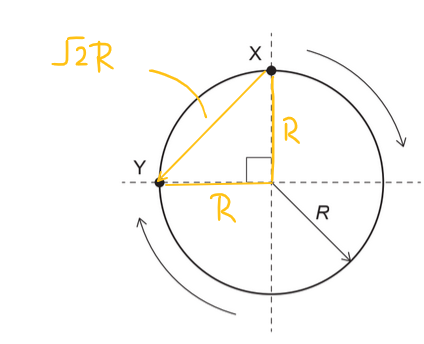Question
A block of mass \(2.0 \mathrm{~kg}\) accelerates uniformly at a rate of \(1.0 \mathrm{~m} \mathrm{~s}^{-2}\) when a force of \(4.0 \mathrm{~N}\) acts on it. The force is doubled while resistive forces stay the same. What is the block’s acceleration?
A. \(4.0 \mathrm{~ms}^{-2}\)
B. \(3.0 \mathrm{~m} \mathrm{~s}^{-2}\)
C. \(2.0 \mathrm{~m} \mathrm{~s}^{-2}\)
D. \( 1.0 \mathrm{~ms}^{-2}\)
▶️Answer/Explanation
Ans:B
We can use Newton’s second law to find the initial resistive force (\(R_1\)) and the final resistive force (\(R_2\)):
1. For the initial case (\(F_1\)), the net force (\(F_{\text{net}_1}\)) is responsible for the initial acceleration (\(a_1\)):
\[F_{\text{net}_1} = F_1 – R_1 = m \cdot a_1\]
Solving for \(R_1\):
\[R_1 = F_1 – m \cdot a_1\]
\[R_1 = 4.0 \, \mathrm{N} – (2.0 \, \mathrm{kg} \cdot 1.0 \, \mathrm{m/s^2}) = 4.0 \, \mathrm{N} – 2.0 \, \mathrm{N} = 2.0 \, \mathrm{N}\]
So, in the initial case, the resistive force (\(R_1\)) is \(2.0 \, \mathrm{N}\).
2. For the final case (\(F_2\)), the net force (\(F_{\text{net}_2}\)) is responsible for the final acceleration (\(a_2\)):
\[F_{\text{net}_2} \Rightarrow F_2 – R_1 = m \cdot a_2\]
Solving for \(a_2\):
\[2.0 \, \mathrm{kg}\cdot a_2 = 8.0 \, \mathrm{N} – 2.0 \, \mathrm{kg} \]
\[6.0 \, \mathrm{N} = 2.0 \, \mathrm{kg} \cdot a_2\]
\[a_2 = 3.0 \, \mathrm{m/s^2}\]
Question
A car travels clockwise around a circular track of radius R. What is the magnitude of displacement from X to Y?

A. \( R \frac{3 \pi}{2}\)
B. \(R \frac{\pi}{2}\)
C. \(R \sqrt{2}\)
D. \(R\)
▶️Answer/Explanation
Ans:C
The displacement from point X to point Y is a chord of the circle and can be represented by the line connecting points X and Y.

Question
A car accelerates uniformly. The car passes point \(X\) at time \(t_1\) with velocity \(v_1\) and point \(Y\) at time \(t_2\) with velocity \(v_2\). The distance \(X Y\) is \(s\).

The following expressions are proposed for the magnitude of its acceleration a:
I. \(a=\frac{2 s}{\left(t_2-t_1\right)^2}\)
II. \(a=\frac{v_2^2-v_1^2}{2 s}\)
III. \(a=\frac{v_2-v_1}{t_2-t_1}\)
Which is correct?
A. I and II only
B. I and III only
C. II and III only
D. I, II and III
▶️Answer/Explanation
Ans:C
To determine which expressions for the magnitude of acceleration (\(a\)) are correct, we can analyze each of the proposed expressions one by one:
I. \(a = \frac{2s}{(t_2 – t_1)^2}\)
Expression I is incorrect because it assumes that the initial velocity \(\left(v_1\right)\) is zero, which may not be the case for the uniformly accelerating car.
II. \(a = \frac{v_2^2 – v_1^2}{2s}\)
This expression is also correct. It’s derived from the kinematic equation for uniformly accelerated motion: \(v^2 = u^2 + 2as\), where \(v_2\) is the final velocity, \(v_1\) is the initial velocity, \(s\) is the displacement, and \(a\) is the acceleration. Solving for \(a\) results in this expression.
III. \(a = \frac{v_2 – v_1}{t_2 – t_1}\)
This expression is also correct and is derived from the definition of acceleration as the rate of change of velocity over time.
So, expressions (II, and III) are correct.
Question
P and Q leave the same point, travelling in the same direction. The graphs show the variation with time t of velocity v for both P and Q.

What is the distance between P and Q when t = 8.0 s?
A 20 m
B 40 m
C 60 m
D 120 m
Answer/Explanation
Ans: B
Distance travelled by P\(=\frac{1}{2}(2)\times 10+(5\times 20)\)
\(=20+100\rightarrow 120\)
Distance travelled by \(Q=\frac{1}{2}(8)\times 40\)
\(=160\)
so , the difference \(= 160- 120 \rightarrow 40\)
Question
The velocity–time graph for an accelerating object that is traveling in a straight line is shown below.

Which of the following is the change in displacement of the object in the first 5.0 seconds?
A. 25.0 m
B. 12.5 m
C. 5.0 m
D. 1.0 m
Answer/Explanation
Markscheme
B
The area under the v- t graph will give the displacement .
\(Area = \frac{1}{2}\times 5\times 5\)
\(= 12.5m\)